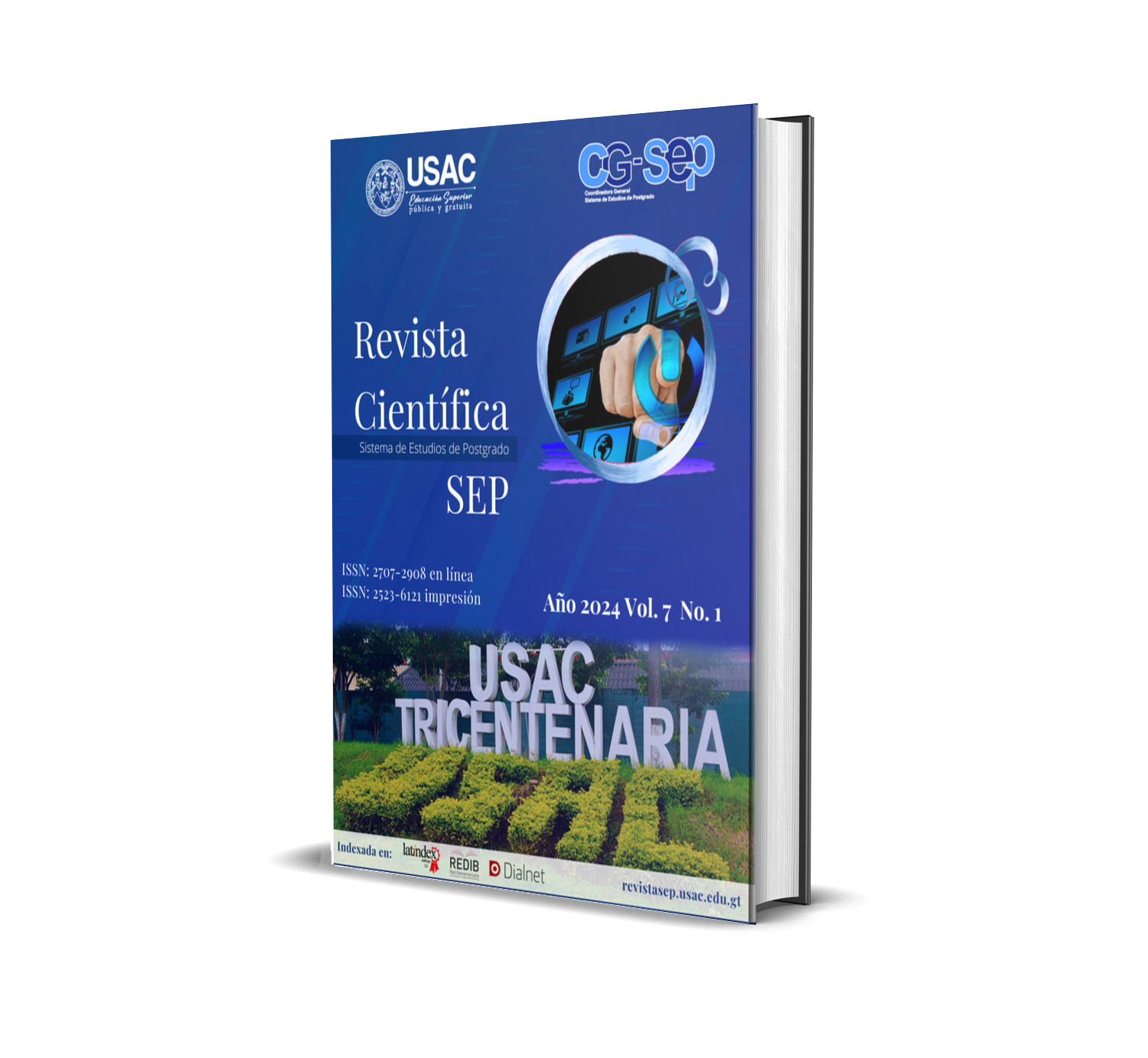Midwife grandmothers as guardians of life and utz k’aslemal (the Good life)
DOI:
https://doi.org/10.36958/sep.v7i1.199Keywords:
midwives, knowledge, childbirth, health, ancestralAbstract
OBJECTIVE: to understand the role of traditional midwives before, during, and after childbirth among Maya K’iche’ women in the Quiché department. METHOD: A qualitative methodology was employed to analyze the role of traditional midwives in K’iche’ communities. A phenomenological approach was used, involving semi-structured, in-depth interviews. The study was conducted in Quiché, which consists of 21 municipalities, 17 of them with a Maya K’iche’ population. Participants included mothers, pregnant women, midwives, healthcare personnel, and community and ancestral authorities. Midwives from the Council of Midwives of Quiché, as well as other lactating and pregnant women and ajq’ijab’ (timekeepers), were included. RESULTS: An in-depth understanding was achieved of the role of traditional midwives during the stages before, during, and after childbirth among Maya K’iche’ women in Quiché. Their political role in the struggle for healthcare for indigenous peoples was highlighted. Despite challenges, the recognition of ancestral medicine remains a constant in the fight for self-determination. CONCLUSION: Medicinal plants continue to be the primary method used by traditional midwives in patient care. The work of traditional midwives can be seen as political, embedded in the resistance dynamics of indigenous peoples. The recognition of ancestral medicine is an ongoing challenge in the struggle for the self-determination of these communities.
Downloads
References
Acuerdo Gubernativo 102-2015. (2015). Política Nacional de Comadronas de los Cuatro Pueblos de Guatemala, 2015-2025. Guatemala. Recuperado el 13 de mayo de 2015, de https://reformas-guatemala.org/pdf/acuerdos_alcanzados/acuerdo_102_2015_politica_comadronas.pdf
Aguirre, G. (1986). Antropología Médica. México. Obtenido de https://www.academia.edu/35667570/Aguirre_Beltran_Antropolog%C3%ADa_m%C3%A9dica
Bagur, M. (2019). Conocimientos, Actitudes y Prácticas que poseen las comadronas tradicionales sobre la alimmentación de la mujer en el puerperio [Tesis]. Guatemala: Universidad de San Carlos de Guatemala. Obtenido de https://biblioteca-farmacia.usac.edu.gt/Tesis/MANA63.pdf
Barrientos, A., Delgado, A., Kopp, R. Estrada, M. Godoy, C., Luna, R. (2011). Conocimientos de las Comadronas sobre los señales de peligro de mortalidad y perinatal [Tesis]. Guatemala: Universdidad de Sal Carlos de Guatemala. Obtenido de http://biblioteca.usac.edu.gt/tesis/05/05_8834.pdf
Car, G. (2005). La herencia de las abuelas y los abuelos en la medicina indígena maya (1a. ed.). Guatemala: ASECSA.
Decreto legislativo 32-2010. (2020). Ley para la Maternidad Saludable. Guatemala. Obtenido de https://oig.cepal.org/sites/default/files/2010_d32-2010_gtm.pdf
Díaz, Z., Aguilar, T., Linares, X. . (2015). La antropología médica aplicada a la salud pública. Revista Cubana de Salud Pública, 41(4), 655-665. Obtenido de http://scielo.sld.cu/scielo.php?script=sci_arttext&pid=S0864-34662015000400009
Fuster, D. (2019). Investigación cualitativa: Método fenomenológico hermenéutico. Revista Propósitos y Representaciones, 1(7), 201-229. doi:http://dx.doi.org/10.20511/pyr2019.v7n1.267 DOI: https://doi.org/10.20511/pyr2019.v7n1.267
Geogrsphic, National. (30 de marzo de 2022). Para Salvar vidas las comadronas mezclan la herencia maya con la medicina ocidental. Obtenido de La lucha por reducir las mmuertes maternas e infantiles en Guatemmala y méxico: https://www.nationalgeographic.es/historia/2022/03/para-salvar-vidas-las-comadronas-mezclan-la-herencia-maya-con-la-medicina-occidental
Hurtado, E. (2010). Estudios de las caracteristicas y prácticas de las comadronas tradicionales en una comunidad indígena de Guatemala [Tesis]. Guatemala: Universidad de San Carlos de Guatemala.
IDEIPI. (7 de 4 de 2022). Instituto de Estudios Interétnicos y de los Pueblos Indígenas. Obtenido de Instituto de Estudios Interétnicos y de los Pueblos Indígenas: https://ideipi.usac.edu.gt/wp-content/uploads/2022/04/COMUNICADO.pdf
Montepeque, F. (05 de octubre de 2022). El tortuoso camino para un cheque de Q57: las comadronas, las peor pagadas por el Estado de Guatemala. Obtenido de https://www.plazapublica.com.gt/content/el-tortuoso-camino-para-un-cheque-de-q57-las-comadronas-las-peor-pagadas-por-el-estado-de
Mosquera, M. (b). (2006). Clasificación y demanda de terapeutas tradicionales en Guatemala. Realidad y Reflexión(18). Obtenido de https://digi.usac.edu.gt/bvirtual/informes/cultura/INF-2006-018.pdf
Mosquera, M., Valdes, A., Paredes, V. (2006). Terapeutas tradicionakles, terapias y racionalidad maya. Elementos para su inserción y consolidación en el pluralismo de salud en Guatemala. Guatemala: DIGI-USAC. Obtenido de https://digi.usac.edu.gt/bvirtual/informes/cultura/INF-2006-018.pdf
Movimiento Nacional de Abuelas Comadronas Nim Alaxik. (2022). Movimiento Nacional de Abuelas Comadronas Nim Alaxik. Obtenido de Movimiento Nacional de Abuelas Comadronas Nim Alaxik: https://feminaction.fr/es/osc/nim-alaxik-guatemala/
Pelcastre, B., Villegas, N., De León, V., Díaz, A., Ortega, D., Santillana, M., Mejía, M. (2005). Embarazo, parto y puerperio: creencias y prácticas de parteras en San Luis Potosí, México. Revista da Escola de Enfermagem da USP, 39(4), 375-382. Obtenido de https://www.scielo.br/j/reeusp/a/fbfMrBbyWrrTqpjPgfXQMMx/ DOI: https://doi.org/10.1590/S0080-62342005000400002
Pies de Occidente. (2001). El Potencial de la comadrona en en Salud Reproductiva (1a. ed.). Quetzaltenango, Guatemala: Pies de Occidente. Obtenido de https://piesdeoccidente.org.gt/biblioteca/El%20Potencial%20de%20la%20Comadrona%20en%20Salud%20Reproductiva.pdf
Wynn, P. y Money, A. (2009). Qualitative Research and Occupational Medicine. Occupational Medicine(59), 138–139. doi:10.1093/occmed/kqn147 DOI: https://doi.org/10.1093/occmed/kqn147
Published
How to Cite
Issue
Section
License
Copyright (c) 2024 Bertha Túm Gregorio

This work is licensed under a Creative Commons Attribution 4.0 International License.
The authors who publish in this journal accept the following conditions:
- The authors retain the copyright and assign to the journal the right of the first publication, with the work registered with the Creative Commons 4.0 attribution license, which allows third parties to use what is published as long as they mention the authorship of the work already the first publication in this magazine.
- Authors may make other independent and additional contractual agreements for the non-exclusive distribution of the version of the article published in this journal (eg, include it in an institutional repository or publish it in a book) provided that they clearly indicate that the work it was first published in this magazine.
- Authors are allowed and encouraged to share their work online (for example: in institutional repositories or personal web pages) before and during the manuscript submission process, as it can lead to productive exchanges, more and more quick citation of published work (see The Effect of Open Access).









